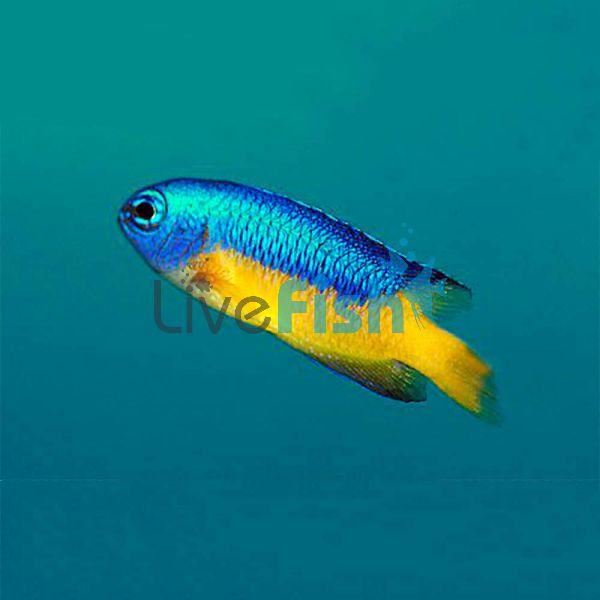Goldbelly Damselfish - Medium
The Goldbelly Damsel is an easy marine fish to keep and so if good for beginners. It's head and the top half of the body is a bright blue with the bottom half of the fish being bright yellow, making it very eye catching.
- Buy 4 for $30.86 each and save 10%
Goldbelly Damselfish
These fish are very easy to care for, which makes them great for people starting with their first saltwater tank.
These bright little fish are hardy and will take a variety of foods, which makes them easy to keep without special care.
The Blue and Yellow sections of their body are split up with the head and top half of the body being blue. The bottom yellow part of their body looks like the letter L. It slants down from the back 1/4th of the dorsal fin and then runs across the middle of the body, stopping just behind the gill plates. When they are stressed their colours tends to fade.
The Goldbelly Damsel is one of the more peaceful Damselfish, yet they are still classed as semi-aggressive.
You can keep these damsels either on their own, as a pair or in small groups.
If keeping these fish with less aggressive fish be aware that as they get older they are likely to become more aggressive which could be a problem in the future. They are likely to be territorial especially with new tank mates.
The Goldbelly Damselfish grows to around a maximum of 2 3/4 inches (7 cm) in length.
In the wild, these Damsels live in the Western Central Pacific Ocean around Micronesia. They prefer areas along inner reef slopes or coastal reefs over patch reefs, rubble flats and rubble slopes.
Tank Recommendations for Goldbelly Damselfish
In the wild, they inhabit areas that have a mix of coral, algae and rubble.
You should provide these fish with plenty of places to hide in rock work or corals as this will help them to feel safe. They also like areas of rubble substrate with algae growth for them. They don't feed on the algae itself, but will snack on the copepods that live within the algae.
They will usually stay near the bottom area of the tank and so need hiding places in this area of the tank.
These fish are just as happy in a reef setting as well as in a fish only tank
< p> The smallest tank size for keeping one of these Damselfish in is 76 litres or you can keep a pair in a 151 litre tank. If you are keeping a group of them together then you should allow at least an extra 57 litres (15 gallons) per fish.
Suitable Tank Buddies
They are the perfect reef fish and will hide amongst corals and live rock at the bottom of the tank. They are coral safe and don't bother clams or ornamental invertebrates, or any other reef creatures. The odd copepod or two may be eaten, they feed on these excessively.
The Goldbelly will pick on other types of smaller less aggressive damsels, they will be picked on by other types of more aggressive damsels.
Usually Compatible
You can keep a group of these Damselfish together providing there is enough tank space for them. They also cohabit well with Basslets, Clownfish, Hogfish, Tangs and Parrotfish.
Sometime Compatible
Peaceful bottom dwellers don't mix well, with the Goldbelly Damsel being territorial. So Gobies, Dartfish, small Wrasses, Dragonets, and Wormfish should be avoided.
Rarely Compatible
Avoid larger semi-aggressive fish like the Moon Wrasse , large Dottybacks, Lionfish and small Groupers as they will eat the Goldbelly Damsel.
Feeding Your Goldbelly Damselfish
These fish are omnivores and in the wild they eat plankton mainly. They primarily eat zooplankton which consists of tiny animals, but may also ingest some tiny plants called phytoplankton.
In the aquarium you can feed them live foods like mysis and brine shrimp and live copepods and rottifers. They will also take shredded frozen seafoods, flake and pellet foods.
Sinking pellets work well as they like to feed near the bottom of the tank, but make sure that you soak them first. This will ensure that air trapped inside the pellets don't get stuck in the fish's digestive tract.
Feeding these fish small amounts of food several times a day is good as it will help to reduce their aggression as they won't feel as protective over the food resources in their little patch of the reef or tank.
| Scientific Name | Pomacentrus auriventris |
|---|




